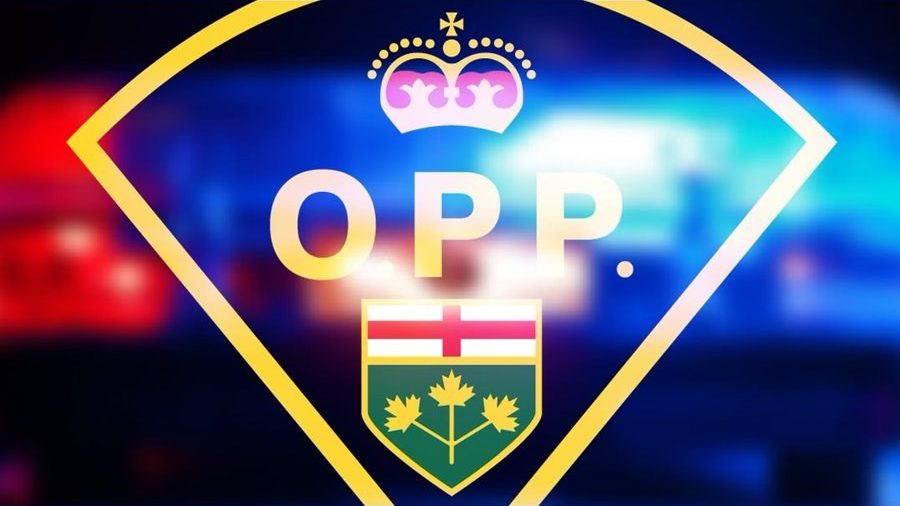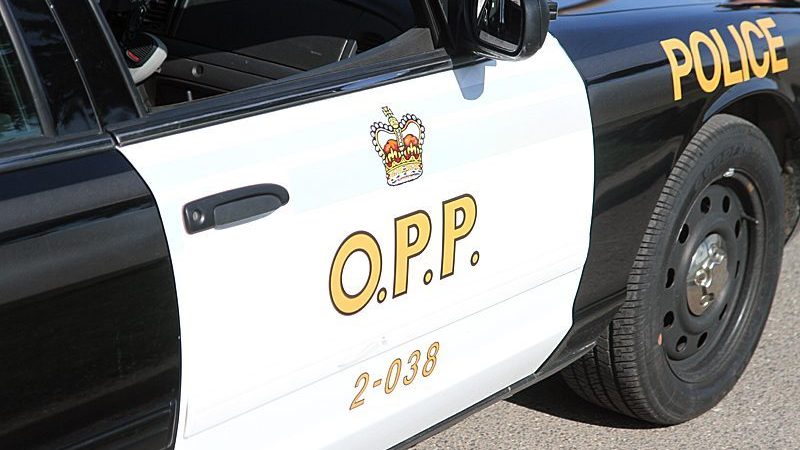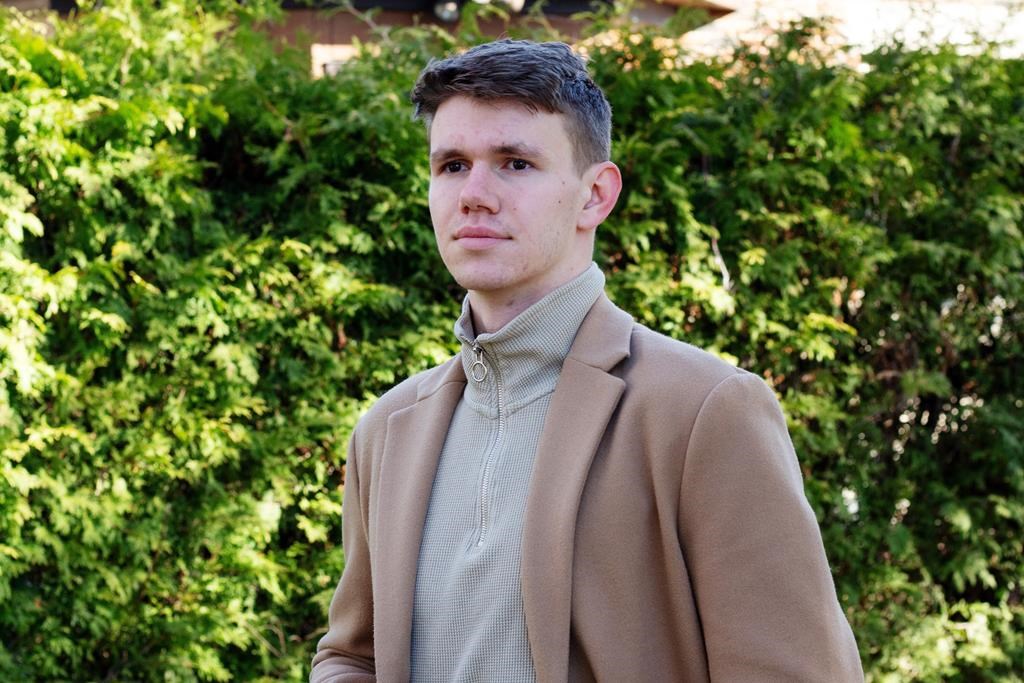Remember This? The funeral of J. Thad Johnson
Posted Jul 5, 2021 01:37:00 PM.
CityNews, in partnership with the Historical Society of Ottawa, brings you this weekly feature by Director James Powell, highlighting a moment in the Ottawa's history.
July 3, 1927
The 50th anniversary of Canada’s Confederation in 1917 came and went with only a token official acknowledgement. The horror of World War I was at its height and Canadians had more important things on their mind. But by the time of the Diamond Jubilee ten years later, Canada was feeling its oats.
The country was at peace, the economy was booming, and, with the 1926 Balfour Declaration just a few months earlier, Canada had been recognized as being the equal of and in no way subordinate to the United Kingdom.
It was time for a party.
Three consecutive days of celebrations, festivities and parades were organized across the country, starting on Dominion Day, Friday, July 1.
With Ottawa festooned with flags and bunting, Day 1 featured the Governor General, the Viscount Willingdon (later the Marquess of Willingdon), laying the cornerstone of the Confederation Building on Wellington Street, followed by the inauguration of the 53-bell carillon in the newly completed Peace Tower, and official speeches on Parliament Hill.
Later that day, a huge parade of floats wended its way through downtown Ottawa. The floats featured exhibits depicting Canadian history, industry, and economic progress. A guest of honour at the festivities was Hortence Cartier, the only surviving daughter of Sir Georges-Étienne Cartier, one of Canada’s leading “fathers” of Confederation.
The highlight of Day 2 of the Jubilee celebrations was a visit by the hero of the hour American Colonel Charles Lindbergh, the “Eagle of the Atlantic.”
Just weeks early, Lindbergh had crossed the Atlantic travelling from New York City to Paris in his single-engine, monoplane The Spirit of St. Louis, specially built by Ryan Airlines and custom designed by the aeronautical engineer Donald Hall. Although this was not the first transatlantic flight, it was almost double the length of that initial 1919 flight from Newfoundland to Ireland by British aviation pioneers John Alcott and Arthur Brown. It took the 25-year old Lindbergh 33 ½ hours to make the solo flight.
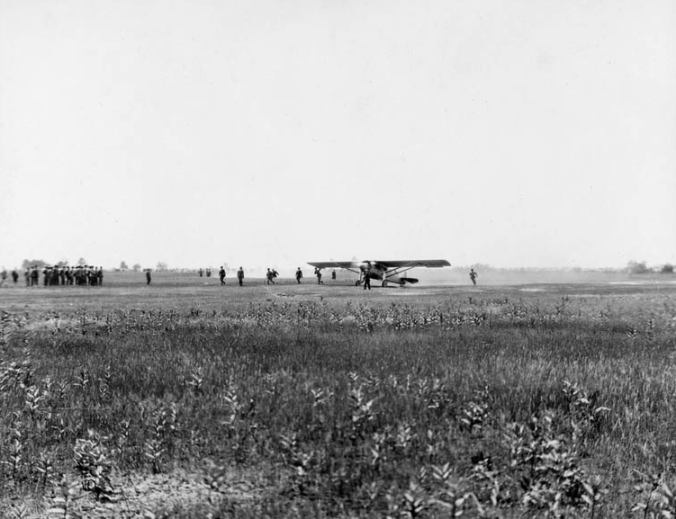
Charles Lindbergh arriving in Ottawa flying The Spirit of St. Louis, 2 July 1927, Library and Archives Canada, PA-027647.
Lindbergh was also invited to Canada to help celebrate the Dominion’s Diamond Jubilee. Accompanying the intrepid aviator on his journey north were 12 airmen of the 1st Pursuit Group of the United States Army Air Service. Based at Selfridge airfield, north of Detroit, Michigan, the Group flew Curtis P-1 Hawk biplanes. Leaving early in the morning of 2 July, the airmen flew directly from their aerodrome, travelling across Lake St. Clair and southern Ontario before heading to Ottawa.
They arrived over a temporary airfield located about a quarter mile from the Ottawa Hunt and Golf Club on the Bowesville Road, roughly the location of the Ottawa Airport today, at 1 p.m., one hour late from their scheduled arrival time. Nobody had informed the flyers that Ottawa was on daylight savings time. (Prior to World War II, the decision to adopt daylight savings time was left up to cities not the province.) A huge crowd, kept back from the landing strip by police and 500 militia members, had assembled to greet the flyers.
After making a tour over Ottawa, Lindbergh safely landed his famous silver-grey airplane, and taxied to the side to make way for the accompanying squadron that was wowing the crowd by swooping low over the fields in its famous “V” formation. The twelve airplanes were divided into four sets of three. Only 25 to 50 feet separated one airplane from
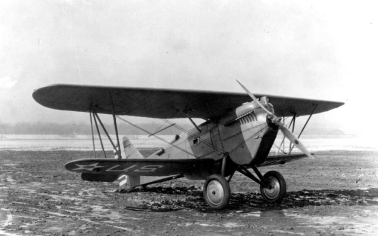
The U. S. Air Force Curtis P-1 Hawk, Wikipedia.
To land, the biplanes went into a “Laffberg circle,” the formation typically used for landing on a small airfield, with each machine touching ground in turn. The first seven airplanes landed without incident. With five still in the air, the leader of the final fourth set, Lieutenant John Thad Johnson, aged 34, unexpectedly side-skipped to the left, the typical indication that for some reason he wished to land out of sequence.
As customary in such situations, the next pilot in line, Lieutenant H. A. Woodring, moved ahead into the position vacated by Johnson. Suddenly, Woodring’s aircraft was struck as Johnson’s airplane reared up, its tail hitting Woodring’s propeller. With its “elevator” sheared off, Johnson’s airplane spun out of control from a height of only three hundred feet.
Johnson initially tried to ride his aircraft down, but at an altitude of only 100 feet, he jumped. Although his parachute functioned properly, there was insufficient time for it to fully deploy. Johnson struck the ground with horrific force, leaving an eighteen-inch depression in the ground. Although doctors and an ambulance had been stationed at the field in the event of an accident, there was nothing that could be done. Death was instantaneous. Johnson’s crippled biplane crashed nose-down 100 yards away. The aviator’s broken wristwatch indicated precisely the time of death: 12:21 p.m., or 1:21 p.m. Ottawa time.
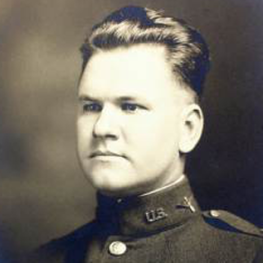
Lieut. J. Thad Johnson, 1893-1927, Born: Johnson City, Texas, Died: Ottawa, Canada. Collection of Troy Benear, Grandnephew of J. Thad Johnson.
The tragedy occurred in front of thousands of stunned onlookers, as well as Col. Lindbergh and the other members of the pursuit squadron.
Immediately, soldiers surrounded Lieutenant Johnson’s crushed body and his downed airplane, holding back the crowds and stopping souvenir hunters. Lindbergh, ashen-faced, was driven to the site of Lieut. Johnson’s body where he paid his respects before being driven away in an open limousine for the official greeting ceremonies on Parliament Hill.
On the Hill, the packed crowds had been waiting for hours in the hot July sun for a glimpse of the famous aviator.
Finally, delayed more than two hours, the shaken Lindbergh arrived on Parliament Hill in the limousine. Few in the cheering multitude were aware of the tragedy that had just occurred.
Despite the strain he was under, Lindbergh, dressed in a double-breasted, blue, serge suit was greeted by Prime Minister Mackenzie King and William Phillips, the American Minister to Canada (equivalent to ambassador). Phillips called Lindbergh the United States’ “unofficial ambassador,” and noted that the aviator, who was born in Detroit, had Canadian blood in his veins; Lindbergh’s grandfather on his mother’s side had been born in Canada.
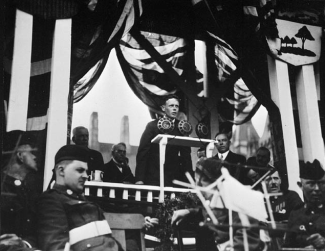
Charles Lindbergh speaking on Parliament Hill, 2 July 1927, Library and Archives Canada, C-006257.
The Prime Minister greeted Lindbergh in the name of the government and the people of Canada. He called the aviator “the embodiment of the spirit of the Happy Warrior,” a gentleman unafraid.”
The visibly stricken Lindbergh spoke for less than ten minutes, pausing between words. After saying, how much he had appreciated the welcome he had received from Canadians, he added that in flying from Detroit he was struck by the need for air transportation in Canada and the United States. Airlines would eliminate distance and would bring Americans and Canadians even closer that they already were.
Nobody mentioned the death of Johnson.
After his short speech, Lindbergh was whisked away to perform his other official duties: meeting the Governor General, going to Lansdowne Park for a series of sporting events, and then back to Mackenzie King’s home, Laurier House, before attending the government dinner on Parliament Hill in honour of William Phillips, the American representative in Canada.
While these events were going on, a coroner’s inquest was hastily held into the death of Johnson. Evidence given by the U.S. airmen suggested that the most likely reason for Johnson’s airplane to go out of control was “propeller wash,” a frequent hazard when planes are flying close to each other. No blame was ascribed to Lieutenant Woodring whose airplane was in collision with Johnson’s. The Crown Attorney conclude that the “most lamentable accident was due to mischance.”
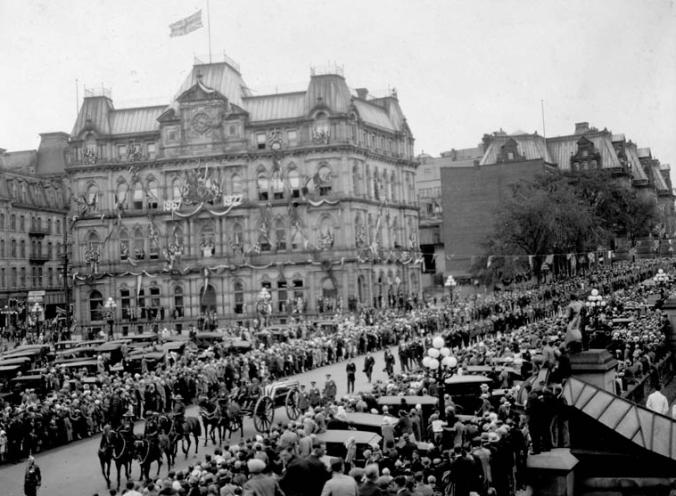
Funeral of Lieut. J. Thad Johnson in from of the old Ottawa Post Office, Wellington Street, Ottawa, 3 July 1927, Library and Archives Canada, PA-0279950.
The Canadian government quickly organized a state funeral for Lieutenant Johnson to be held the following day, July 3, Day 3 of the Jubilee celebration.
His body was placed in a bronze casket, and conveyed to the East Block of the Parliament Buildings. There, he laid in state through the morning and early afternoon. Members of the RCAF stood with bowed heads at each corner of the casket which was draped with the American Stars and Stripes. Thousands passed by the flower-bedecked bier.
After a curtailed Jubilee Thanksgiving Service held at the Auditorium presided over by the Governor General, Canadian officials and other dignitaries hurried over to Parliament Hill to pay their respects to the fallen airman and to attend his funeral. Reverend (Major) H. I. Horsey of the 38th Royal Ottawa Highlanders read the service.
More than 25,000 people watched the proceedings and the imposing military funeral cortege. Camille Lefebvre, assistant carillonneur of the cathedral at Malines, Belgium, played Chopin’s Death March followed by Handel’s Death March from Saul, on the newly-inaugurated carillon in the Peace Tower. The Union Jack above Parliament was lowered out of respect for the fallen aviator.
After the funeral, the flag-draped casket was carefully placed on a horse-drawn gun carriage, and, to muffled drums, was drawn slowly to the train station, escorted by RCMP officers in their scarlet dress uniforms. On either side were three RCAF flying officers acting as honorary pallbearers. Leading the cortege was the band of the Governor General’s Foot Guards, followed by a firing party and buglers.
Official mourners included the Prime Minister, the U.S. Minister to Canada, and Vincent Massey, the Canadian Envoy to the United States who had hurried up to Ottawa from Washington, as well as the Chairman of the Jubilee Committee, Cabinet members, senior militia officers, civil servants, and the Boy Scouts. More than 100 officers and 1,000 other ranks, from almost every military unit in the region, were represented.
When the funeral cortege halted in front of the Chateau Laurier Hotel, seven members of the U.S. Pursuit team swooped down low before climbing high again to salute Lieutenant Johnson.
At Union Station, its cheery Jubilee bunting removed in favour of funereal black and purple, the casket was transferred into the care of a U.S. army official, and conveyed to a special funeral train organized by Canadian National Railway for Lieutenant Johnson’s last trip back to Selfridge Field, Michigan. After the train left the station, Colonel Lindbergh, flying The Spirit of St. Louis, threw peonies over the carriage as a final tribute to the fallen airman. Railwaymen collected the blossoms so that they could be delivered to Johnson’s young widow; the couple had been married only a year.
Lieutenant Johnson’s remains were buried the following day in Fenton, Michigan.
Today, a small road called Thad Johnson Private, located near the Ottawa airport not far from where the pilot fell to his death, honours the memory of the American Pursuit pilot.


